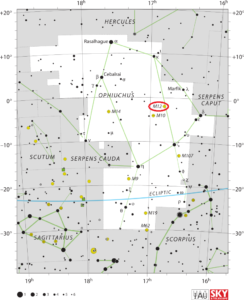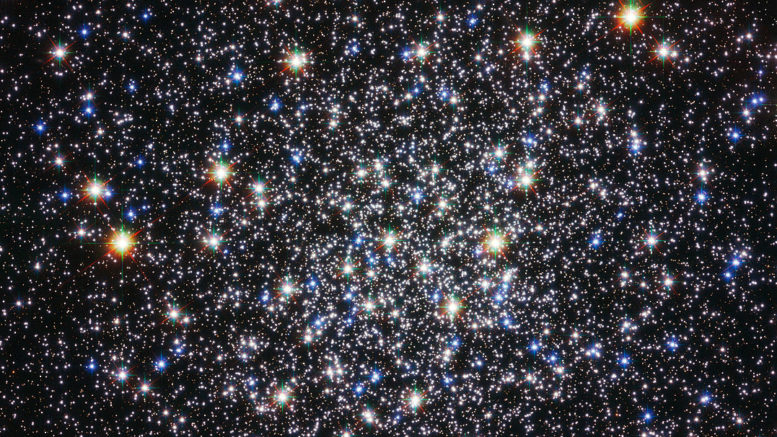Messier 12 is located 15,700 light-years from Earth in the constellation Ophiuchus with an apparent magnitude of 7.7 and can be observed with a pair of binoculars most easily in July. Come learn about how to find the object and much more!
| Description | |
| Visible From Pacific Northwest | May through July |
| Best Time To Observe | July |
| Minimum Size Of Viewing Device | Binoculars |
| Object Type | Globular Cluster |
| Designations | Messier 12, M12, NGC 6218, C 1644-018, GCl 46 |
| Right Ascension | 16h 47m 14.18s |
| Declination | -01°56’54.7” |
| Constellation | Ophiuchus |
| Number Of Stars | 200,000 stars |
| Apparent magnitude | +7.68 |
| Apparent dimensions | 16′ |
| Object Radius | 37.2 light years |
| Distance From Earth | 15,700 light years |
History
It was discovered by the French astronomer Charles Messier on May 30, 1764, who described it as a “nebula without stars.” He would also write that the “Nebula discovered in the Serpent, between the arm and the left side of Ophiuchus: this nebula contains no star, it is round & its light is faint; near this nebula there is a star of 9th magnitude.”
William Herschel was the first to resolve the cluster into individual stars. He noted, “1783, 1799, 10 feet telescope. With 120, and an aperture of 4 inches, easily resolvable; with 5 inches, stars become visible; with 6 inches, pretty distinctly visible; and with all open, the lowest power shows the stars.”
Sir William Herschel resolved this object in 1783; and through his the gauging process, he held its profundity to be of the 186th order.
Locating M12 In The Sky
Finding M12 can be rather tricky, but start by locating Rasalhague (α Oph – mag +2.1) the brightest star in Ophiuchus. Join the stars of Ophiuchus in a curve heading westwards and southwards until arriving at two close together 3rd magnitude stars, Yed Prior (δ Oph – mag. +2.7) and Yed Posterior (ε Oph – mag. +3.2). M12 is located about 8 degrees northeast of the stars. Positioned 3.25 degrees southeast of M12 is M10, with the star 30 Oph (mag. +4.8) located one degree east of M10.

Viewing M12
Messier 12 is invisible to the naked eye, but can be seen with binoculars in good conditions, with clear dark skies and no light pollution. Stars in the cluster can be resolved with an 8-inch or larger telescope. A 10-inch instrument reveals the core with a diameter of 3 arc minutes and a halo of stars stretching across an area of 10 arc minutes.
Photographing M12
Messier 12 can be photographed with a large telescope that does tracking, but there aren’t many sites that can provide assistance online. This isn’t necessarily a popular target and one that one can find guidance on online in a readily available fashion.
Sources And Further Reading
Descriptions of all of Messier Objects can be found here.
http://freestarcharts.com/messier-12
https://www.nasa.gov/feature/goddard/2017/messier-12/

Be the first to comment on "Messier 12"